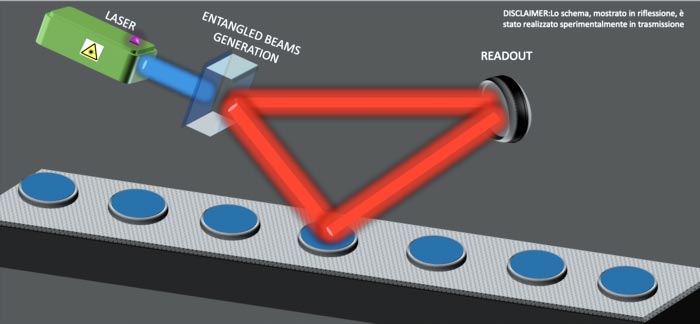Quantum mechanics at the service of the products and production processes quality

Quantum Conformance Test
Credit: Ivano Ruo Berchera - INRiM Senior Researcher, Giuseppe Ortolano - phD student from Politecnico di Torino (first author of the research) and INRiM Researcher Pauline Boucher, Ivo Pietro Degiovanni, Elena Losero, Marco Genovese (Director of the Quantum Optics research sector of INRiM)
In an article published in the prestigious journal Science Advances, researchers* from Politecnico di Torino and National Institute of Metrological Research (INRiM) have proposed an innovative approach, based on quantum technologies, to check if a production process conforms to a reference or if it a “defective” one.
An effective monitoring of the production processes is fundamental both for the safety of the released products and the economic efficiency of the process itself. Conformity tests are often performed with measurements on a random subset of the final products.
Exactly in this scenario, the researchers have shown that making use of quantum “entangled” light sources can notably reduce the probability of having classification errors – conform or defective – at a fixed irradiated energy on the samples, improving substantially the efficiency of the monitoring. Entanglement (between two beams of photons) in quantum mechanics is the existence of a degree of correlation higher than what is possible in “classical” light sources (that is, they can be described in terms of classical physics).
The same article reports the experimental realization of what the Politecnico di Torino and INRiM’s Researchers have called “Quantum Conformance Test”. In short, one of two entangled beams of light interacts with the tested object while the other one is used to measure the light fluctuation with high precision. The experiment shows how the quantum conformance test can be realized with present technology available in laboratories, thus in perspective transportable toward practical applications in the near future.
Important examples are optical transmittance measurements and spectroscopy, useful for the characterization, for example, of chemical concentrations and biological samples. Since each substance absorb light in a different way for different optical frequencies (colors, in the visible spectrum), its concentration can be estimated by means of an optical transmissivity measurement, i.e., measuring the intensity before and after the test object. However, the production process is affected by statistical fluctuations so that the concentrations, and consequently the optical intensity transmitted, will be distributed around a reference value.
Intrinsic fluctuations in conventional light sources typically used for optical measurements, including lasers, reduce the accuracy in the characterization of the products. This limitation is particularly relevant in case of photosensitive samples, for which it is fundamental to use low-intensity light and to keep small the number of products tested over the whole production. In this situation, the effect of intensity fluctuations of the light source is amplified. The protocol, developed by the researchers and illustrated in the article, shows excellent prospects for reducing the margin of error in monitoring of this type.
The research has received funding from the European Union’s Horizon 2020 research and innovation programme under grant agreement No 862644, ‘Quantum readout techniques and technologies’ (QUARTET).
[*] Giuseppe Ortolano, Pauline Boucher, Ivo Pietro Degiovanni, Elena Tosero, Marco Genovese, Ivano Ruo-Berchera. Quantum Conformance Test, SCIENCE ADVANCES (2021), URL: https://www.science.org/doi/10.1126/sciadv.abm3093
Journal: Science Advances
DOI: 10.1126/sciadv.abm3093
Media Contact
Barbara Fracassi
INRIM – Istituto Nazionale di Ricerca Metrologica
comunicazione@inrim.it
All latest news from the category: Physics and Astronomy
This area deals with the fundamental laws and building blocks of nature and how they interact, the properties and the behavior of matter, and research into space and time and their structures.
innovations-report provides in-depth reports and articles on subjects such as astrophysics, laser technologies, nuclear, quantum, particle and solid-state physics, nanotechnologies, planetary research and findings (Mars, Venus) and developments related to the Hubble Telescope.
Newest articles

Innovative 3D printed scaffolds offer new hope for bone healing
Researchers at the Institute for Bioengineering of Catalonia have developed novel 3D printed PLA-CaP scaffolds that promote blood vessel formation, ensuring better healing and regeneration of bone tissue. Bone is…

The surprising role of gut infection in Alzheimer’s disease
ASU- and Banner Alzheimer’s Institute-led study implicates link between a common virus and the disease, which travels from the gut to the brain and may be a target for antiviral…

Molecular gardening: New enzymes discovered for protein modification pruning
How deubiquitinases USP53 and USP54 cleave long polyubiquitin chains and how the former is linked to liver disease in children. Deubiquitinases (DUBs) are enzymes used by cells to trim protein…


